
-
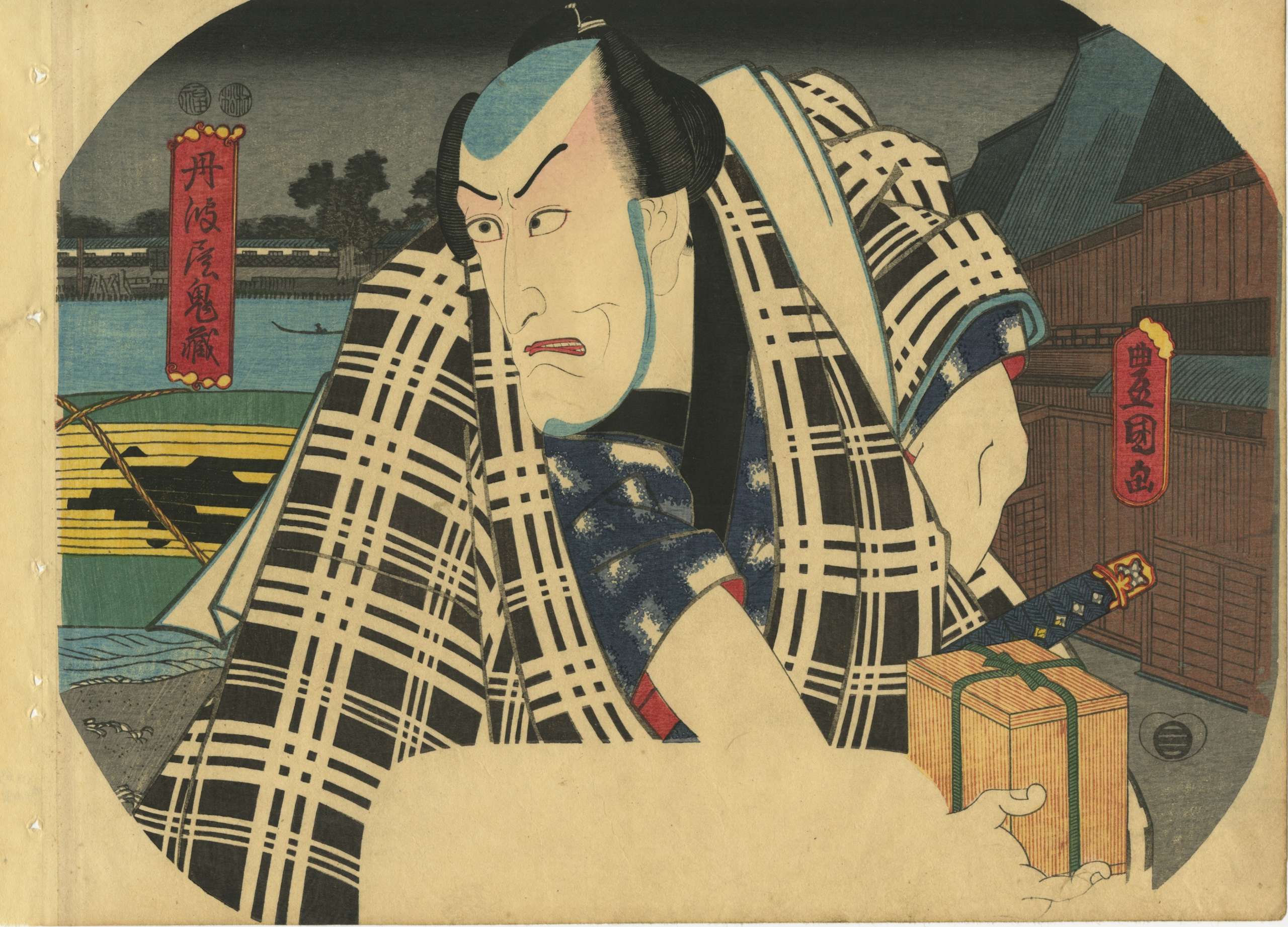 Artist: Utagawa Kunisada [歌川 国貞] a.k.a. Utagawa Toyokuni III [三代歌川豊国] (Japanese, 1786 – 1865). Signed: Toyokuni ga [豊国 画] in a red toshidama cartouche. Actor: Ichikawa Danjūrō VII 市川団十郎 (Japanese, 1791 – 1859); other names: Ichikawa Ebizō V, Ichikawa Hakuen II, Ichikawa Shinnosuke I. Character: Tanbaya Onizo [丹波屋鬼蔵] Play: Koi Bikyaku Yamato Orai [恋飛脚大和往来] Performance: Kawarasaki Theatre [河原崎座] in the 2nd month of 1851. Double nanushi censor seals: Fuku & Muramatsu, from 3rd month of Kaei 2 to 11th month of Kaei 4 (1849-51). Another fan print from the pair SVJP-0212-2.2016: Sawamura Chōjūrō V as Kameya Chubei.
Artist: Utagawa Kunisada [歌川 国貞] a.k.a. Utagawa Toyokuni III [三代歌川豊国] (Japanese, 1786 – 1865). Signed: Toyokuni ga [豊国 画] in a red toshidama cartouche. Actor: Ichikawa Danjūrō VII 市川団十郎 (Japanese, 1791 – 1859); other names: Ichikawa Ebizō V, Ichikawa Hakuen II, Ichikawa Shinnosuke I. Character: Tanbaya Onizo [丹波屋鬼蔵] Play: Koi Bikyaku Yamato Orai [恋飛脚大和往来] Performance: Kawarasaki Theatre [河原崎座] in the 2nd month of 1851. Double nanushi censor seals: Fuku & Muramatsu, from 3rd month of Kaei 2 to 11th month of Kaei 4 (1849-51). Another fan print from the pair SVJP-0212-2.2016: Sawamura Chōjūrō V as Kameya Chubei.
-
 Iron tsuba of round form decorated with chrysanthemums, pine cones and needles, pampas grass, vines, cherry blossoms, and wild geese in brass inlay (suemon-zōgan) and pierced with designs of water clover (denjiso) and half bellflower (or karahana) to the left and to the right of nakago-ana as well as double bars above and below nakago-ana (possibly with the meaning of number 2 or ordinal 2nd). Most probably the sukashi elements here are the family crests (mon). Unsigned. Ōnin school. Muromachi period; 15th or 16th century. Height: 82.1 mm; Width: 80.9 mm; Thickness at seppa-dai: 2.4 mm NBTHK # 2003827: Tokubetsu Hozon Tosogu Kanteisho (特別保存刀装具鑑定書) - "Extraordinarily Worthy of Preservation".
Iron tsuba of round form decorated with chrysanthemums, pine cones and needles, pampas grass, vines, cherry blossoms, and wild geese in brass inlay (suemon-zōgan) and pierced with designs of water clover (denjiso) and half bellflower (or karahana) to the left and to the right of nakago-ana as well as double bars above and below nakago-ana (possibly with the meaning of number 2 or ordinal 2nd). Most probably the sukashi elements here are the family crests (mon). Unsigned. Ōnin school. Muromachi period; 15th or 16th century. Height: 82.1 mm; Width: 80.9 mm; Thickness at seppa-dai: 2.4 mm NBTHK # 2003827: Tokubetsu Hozon Tosogu Kanteisho (特別保存刀装具鑑定書) - "Extraordinarily Worthy of Preservation". -
 Iron tsuba of round form inlaid with brass, copper, and shakudō wire fastened to the surface with metal staples (mukade-zōgan); Scalloped brass inlay around the rim. Early Edo, 17th century. Height: 84.8 mm; Width 84.8 mm; Thickness at seppa-dai: 3.7 mm. Weight 161.6 g. Design is thought to resemble a centipede. "Centipede-like inlay (mukade zogan) of alternating iron and brass staples produce an appearance that was particularly favored by Takeda Shingen (1521-1573), one of the most powerful warlords of his time. The centipede is sacred to Bishamon (God of War) and especially propitious for a warrior. Shingen type, 16th century.” [The Peabody Museum collection of Japanese sword guards with selected pieces of sword furniture, by John D. Hamilton. Photographs by Mark Sexton. Salem, MA, 1975.] See also: http://varshavskycollection.com/shingen-tsuba/
Iron tsuba of round form inlaid with brass, copper, and shakudō wire fastened to the surface with metal staples (mukade-zōgan); Scalloped brass inlay around the rim. Early Edo, 17th century. Height: 84.8 mm; Width 84.8 mm; Thickness at seppa-dai: 3.7 mm. Weight 161.6 g. Design is thought to resemble a centipede. "Centipede-like inlay (mukade zogan) of alternating iron and brass staples produce an appearance that was particularly favored by Takeda Shingen (1521-1573), one of the most powerful warlords of his time. The centipede is sacred to Bishamon (God of War) and especially propitious for a warrior. Shingen type, 16th century.” [The Peabody Museum collection of Japanese sword guards with selected pieces of sword furniture, by John D. Hamilton. Photographs by Mark Sexton. Salem, MA, 1975.] See also: http://varshavskycollection.com/shingen-tsuba/ -
 Kitagawa Utamaro. According to Chris Uhlenberg this is an illustration from the book Ehon koi no Onamaki, 3 vols, published in Kansei 11 (1799). Illustrated in b/w in: Hayashi Yoshikazu: Kitagawa Utamaro, in the series: Edo makura-e shi shusei, published in 1990, reissued 1994. Size: Chuban (25.5 x 18.5 cm), two book pages glued together.
Kitagawa Utamaro. According to Chris Uhlenberg this is an illustration from the book Ehon koi no Onamaki, 3 vols, published in Kansei 11 (1799). Illustrated in b/w in: Hayashi Yoshikazu: Kitagawa Utamaro, in the series: Edo makura-e shi shusei, published in 1990, reissued 1994. Size: Chuban (25.5 x 18.5 cm), two book pages glued together. -

Iron tsuba of round form pierced (sukashi) and carved (marubori) with a 'noshi' decoration design. Noshi - decoration made of dried abalone (awabi) and bearing an auspicious connotation of good fortune, prosperity, etc. Design was used as a family crest (mon).
Size: 76.3 x 75.9 x 5.5 mm.
Signed: Echizen jū Kinai Saku. Kinai school existed from mid 17th to mid 19th century; it is hard to tell which master (generation from 1 to 6) made this particular piece.
SOLD -
 Katsukawa Shun'ei (勝川 春英; 1762 – 1819).TITLE: Sawamura Sôjûrô III as Kakogawa Honzô.SERIES: Kanadehon Chūshingura (Kana practice book: Treasury of the loyal retainers").DATE: 1795Signed: Shun'ei ga (春英画). Publisher: Iwatoya Kisaburō, Marks 173/p.169. Vertical Ōban: 14.75 x 9.625 inchOn 4th lunar month of 1795 Sôjûrô plays the roles of En'ya Hangan and Kakogawa Honzô in the drama "Kanadehon Chûshingura" at Miyakoza theater in Edo.
Katsukawa Shun'ei (勝川 春英; 1762 – 1819).TITLE: Sawamura Sôjûrô III as Kakogawa Honzô.SERIES: Kanadehon Chūshingura (Kana practice book: Treasury of the loyal retainers").DATE: 1795Signed: Shun'ei ga (春英画). Publisher: Iwatoya Kisaburō, Marks 173/p.169. Vertical Ōban: 14.75 x 9.625 inchOn 4th lunar month of 1795 Sôjûrô plays the roles of En'ya Hangan and Kakogawa Honzô in the drama "Kanadehon Chûshingura" at Miyakoza theater in Edo. -

Small iron tsuba (tantō size) of aoi form with the design of paulownia leaves and blossoms in copper and brass flat inlay (hira-zōgan). Brass sekigane. Open kozuka hitsu-ana.
Early Edo period, 17th century.
Size: 53.4 x 40.7 x 4.4 mm; weight: 47.4 g
-
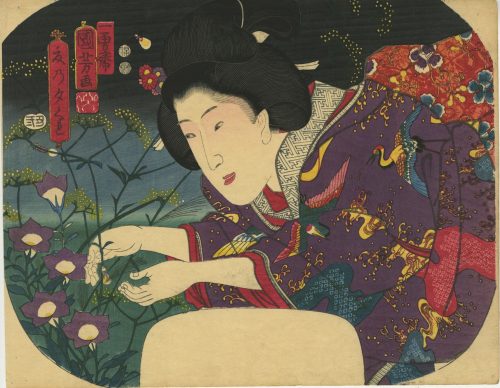 Artist: Utagawa Kuniyoshi [歌川 國芳] (Japanese, 1798 – 1861). Publisher: Enshuya Matabei [遠州屋又兵衛] (Japanese, fl. c. 178 – 1881) – no seal, ref: Kunisada Project. Title: A Summer Evening [夏乃夕暮] (Natsu no Yūgure). A young woman in purple kimono decorated with cranes and waves catching a firefly among yellow and purple flowers. Signed: Ichiyosai Kuniyoshi ga [一勇斎 国芳 画] in a red cartouche and sealed with paulownia (kiri mon). Date seal and double nanushi censor seals: Fuku & Muramatsu, 1853 (Kaei 6, 2nd month). No publisher's seal. Size: Uchiwa-e (untrimmed fan print) 228 x 296 mm. The yellow flower is probably Patrinia scabiosifolia (ominaeshi) [女郎花]. The purple flower seems to be Platycodon grandiflorus or Balloon Flower (kikyō) [桔梗]. Besides, there are visible panicles of Miscanthus sinensis, or Japanese pampas grass (susuki) [薄]. These three are part of the Seven Grasses of Autumn (aki no nanakusa) [秋の七草].
Artist: Utagawa Kuniyoshi [歌川 國芳] (Japanese, 1798 – 1861). Publisher: Enshuya Matabei [遠州屋又兵衛] (Japanese, fl. c. 178 – 1881) – no seal, ref: Kunisada Project. Title: A Summer Evening [夏乃夕暮] (Natsu no Yūgure). A young woman in purple kimono decorated with cranes and waves catching a firefly among yellow and purple flowers. Signed: Ichiyosai Kuniyoshi ga [一勇斎 国芳 画] in a red cartouche and sealed with paulownia (kiri mon). Date seal and double nanushi censor seals: Fuku & Muramatsu, 1853 (Kaei 6, 2nd month). No publisher's seal. Size: Uchiwa-e (untrimmed fan print) 228 x 296 mm. The yellow flower is probably Patrinia scabiosifolia (ominaeshi) [女郎花]. The purple flower seems to be Platycodon grandiflorus or Balloon Flower (kikyō) [桔梗]. Besides, there are visible panicles of Miscanthus sinensis, or Japanese pampas grass (susuki) [薄]. These three are part of the Seven Grasses of Autumn (aki no nanakusa) [秋の七草]. -
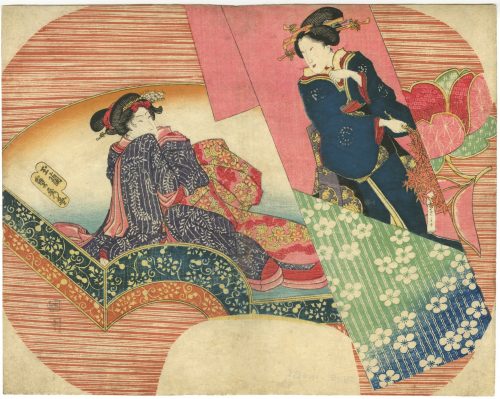 Artist: Utagawa Sadahide [歌川貞秀] (Japanese, 1807 – 1879). Publisher: Kojimaya Jūbei [小島屋重兵衛] (Japanese, c. 1797 – 1869); seal: Marks #264, p. 210) Signed: Gyokuransai Sadahide ga [玉蘭斎貞秀 画]. Date seal: 1830 (Bunsei 13 / Tenpō 1). Size: Uncut fan print (uchiwa-e); 229 x 292 mm
Artist: Utagawa Sadahide [歌川貞秀] (Japanese, 1807 – 1879). Publisher: Kojimaya Jūbei [小島屋重兵衛] (Japanese, c. 1797 – 1869); seal: Marks #264, p. 210) Signed: Gyokuransai Sadahide ga [玉蘭斎貞秀 画]. Date seal: 1830 (Bunsei 13 / Tenpō 1). Size: Uncut fan print (uchiwa-e); 229 x 292 mm -
 Artist: Utagawa Kunisada [歌川 国貞] a.k.a. Utagawa Toyokuni III [三代歌川豊国] (Japanese, 1786 – 1865). Block cutter: Yokokawa Takejirō [横川竹二郎] (Japanese, fl. 1845 – 1863), seal Hori Take [彫竹]. Publisher: Ibaya Senzaburō [伊場屋仙三郎] (Japanese, fl. C. 1845 – 1847). Title: Book of an incoming ship [入船帳] (Irifune-chō). Series: Comparison of Eight Books of Proficiency and Eloquence [口も手も美立八帳] (Kuchimo temo mitate hatchō). Date seal and aratame censor seal: 1856 (Ansei 3). Signed: Toyokuni ga in toshidama cartouche. Media: Untrimmed fan print (uchiwa-e), 231 x 300 mm. Provenance: The Collection of Paul F. Walter, Christie's, New York, 2017, lot 341; sold together with 5 other fan prints for $25,000. Before: Israel Goldman, Japanese Prints, Catalogue 11, 2005, no. 37. Ref: [LIB-1693.2018] The Collection of Paul Walter. — NY: Christie's, 2017, p. 363. Ref: Israel Goldman, Catalogue 2018, № 51: "Utagawa Kunisada (1786-1865) A Beauty Seated in a Boat. From the series Mitate hatcho (A Parody of Eight Books). 1856. Fan print. 23.3 x 30 cm. Provenance: Israel Goldman, Japanese Prints, Catalogue 11, 2005, no. 37, The Collection of Paul F. Walter, Christie's, New York, 2017, lot 341. Fine impression, colour and condition. The title contains the saying: “Kuchi mo hatcho te mo hatcho (As quick with one’s hand as one’s tongue)." Special thanks to Horst Graebner for the detailed description.
Artist: Utagawa Kunisada [歌川 国貞] a.k.a. Utagawa Toyokuni III [三代歌川豊国] (Japanese, 1786 – 1865). Block cutter: Yokokawa Takejirō [横川竹二郎] (Japanese, fl. 1845 – 1863), seal Hori Take [彫竹]. Publisher: Ibaya Senzaburō [伊場屋仙三郎] (Japanese, fl. C. 1845 – 1847). Title: Book of an incoming ship [入船帳] (Irifune-chō). Series: Comparison of Eight Books of Proficiency and Eloquence [口も手も美立八帳] (Kuchimo temo mitate hatchō). Date seal and aratame censor seal: 1856 (Ansei 3). Signed: Toyokuni ga in toshidama cartouche. Media: Untrimmed fan print (uchiwa-e), 231 x 300 mm. Provenance: The Collection of Paul F. Walter, Christie's, New York, 2017, lot 341; sold together with 5 other fan prints for $25,000. Before: Israel Goldman, Japanese Prints, Catalogue 11, 2005, no. 37. Ref: [LIB-1693.2018] The Collection of Paul Walter. — NY: Christie's, 2017, p. 363. Ref: Israel Goldman, Catalogue 2018, № 51: "Utagawa Kunisada (1786-1865) A Beauty Seated in a Boat. From the series Mitate hatcho (A Parody of Eight Books). 1856. Fan print. 23.3 x 30 cm. Provenance: Israel Goldman, Japanese Prints, Catalogue 11, 2005, no. 37, The Collection of Paul F. Walter, Christie's, New York, 2017, lot 341. Fine impression, colour and condition. The title contains the saying: “Kuchi mo hatcho te mo hatcho (As quick with one’s hand as one’s tongue)." Special thanks to Horst Graebner for the detailed description. -
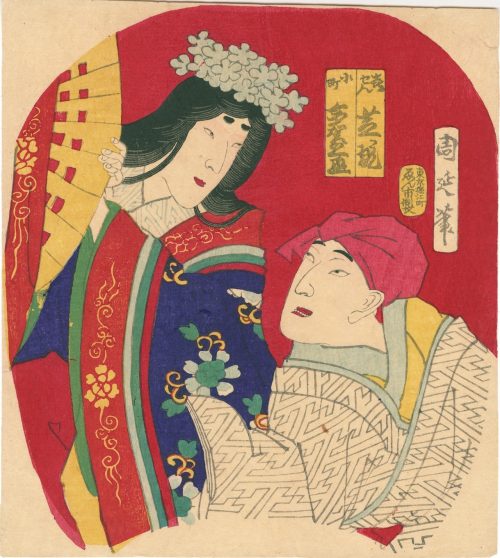 Artist: Toyohara Chikanobu [豊原周延] (Japanese, 1838 – 1912) Signed: Chikanobu hitsu [周延筆] Publisher: [ 東京掘江町] Tokyo Horiemachi | [えん市製] Enshi-sei. Media: Fan print (uchiwa-e, 団扇絵), 192 x 172 mm. Possibly Iwai Kumesaburō IV [岩井粂三郎] (1856 – 1886) a.k.a. Iwai Hisajirō III [岩井久次郎] in the role of Ono no Komachi [小野乃小町] and Nakamura Shikan IV [中村芝翫] in the role of Kisen Hōshi [喜せん法師]. Play: The Six Immortal Poets in Colorful Guises [六歌仙体綵] (Rokkasen Sugata no irodori). Inscription: Left: Kisen [喜せん] | Shikan [芝翫] Right: Komachi [小町] | Kumesaburō [粂三郎]. Actors: Iwai Kumesaburō IV [岩井粂三郎] (1856 – 1886) a.k.a. Iwai Hisajirō III [岩井久次郎]. Nakamura Shikan IV [中村芝翫] (Japanese, 1831 – 1899); other names: Nakamura Fukusuke I [中村福助], Nakamura Masanosuke I, Nakamura Komasaburō, Nakamura Tamatarō I.
Artist: Toyohara Chikanobu [豊原周延] (Japanese, 1838 – 1912) Signed: Chikanobu hitsu [周延筆] Publisher: [ 東京掘江町] Tokyo Horiemachi | [えん市製] Enshi-sei. Media: Fan print (uchiwa-e, 団扇絵), 192 x 172 mm. Possibly Iwai Kumesaburō IV [岩井粂三郎] (1856 – 1886) a.k.a. Iwai Hisajirō III [岩井久次郎] in the role of Ono no Komachi [小野乃小町] and Nakamura Shikan IV [中村芝翫] in the role of Kisen Hōshi [喜せん法師]. Play: The Six Immortal Poets in Colorful Guises [六歌仙体綵] (Rokkasen Sugata no irodori). Inscription: Left: Kisen [喜せん] | Shikan [芝翫] Right: Komachi [小町] | Kumesaburō [粂三郎]. Actors: Iwai Kumesaburō IV [岩井粂三郎] (1856 – 1886) a.k.a. Iwai Hisajirō III [岩井久次郎]. Nakamura Shikan IV [中村芝翫] (Japanese, 1831 – 1899); other names: Nakamura Fukusuke I [中村福助], Nakamura Masanosuke I, Nakamura Komasaburō, Nakamura Tamatarō I. -
 Iron tsuba of round form decorated with eight roundels – circular emblems of flowers and/or family crests (mon) made of cast brass, pierced and chiselled in kebori, and with flat brass inlay (hira-zōgan) of vines or leaves all over the plate. Both hitsu-ana are trimmed with brass. Nakago-ana of trapezoidal form. A distinctive character of this tsuba is a mon at 12 hours, depicting paulownia, or Kiri-mon [桐紋] – a symbol of the Toyotomi clan, led by Toyotomi Hideyoshi (豊臣 秀吉, 1537 – 1598). Kiri-mon was also used as fuku-mon (alternative family crests) for the Imperial Family and Imperial Court. Another important emblem at 6 o’clock is the Katakura clan [片倉氏, Katakura-shi] family crest. Katakura Kagetsuna (片倉 景綱, 1557 – 1615), a retainer of Date Masamune (伊達 政宗, 1567 – 1636); Kagetsuna was operational in Hideyoshi’s Odawara campaign in 1590, which ultimately ended the unification of Japan. Unsigned but may be attributed to Koike Yoshirō Naomasa or his workshop (Yoshirō, orKaga-Yoshirō school). Dimensions: Diameter: 85.5 mm; Thickness at seppa-dai: 5.0 mm.
Iron tsuba of round form decorated with eight roundels – circular emblems of flowers and/or family crests (mon) made of cast brass, pierced and chiselled in kebori, and with flat brass inlay (hira-zōgan) of vines or leaves all over the plate. Both hitsu-ana are trimmed with brass. Nakago-ana of trapezoidal form. A distinctive character of this tsuba is a mon at 12 hours, depicting paulownia, or Kiri-mon [桐紋] – a symbol of the Toyotomi clan, led by Toyotomi Hideyoshi (豊臣 秀吉, 1537 – 1598). Kiri-mon was also used as fuku-mon (alternative family crests) for the Imperial Family and Imperial Court. Another important emblem at 6 o’clock is the Katakura clan [片倉氏, Katakura-shi] family crest. Katakura Kagetsuna (片倉 景綱, 1557 – 1615), a retainer of Date Masamune (伊達 政宗, 1567 – 1636); Kagetsuna was operational in Hideyoshi’s Odawara campaign in 1590, which ultimately ended the unification of Japan. Unsigned but may be attributed to Koike Yoshirō Naomasa or his workshop (Yoshirō, orKaga-Yoshirō school). Dimensions: Diameter: 85.5 mm; Thickness at seppa-dai: 5.0 mm.
Kiri-mon

Katakura-mon
-
 Iron tsuba of quatrefoil form with design of bamboo stems and leaves, and a plank bridge in openwork (sukashi). Hitsu-ana of irregular form. Iron with smooth chocolate patina. Copper and shakudō sekigane. This piece is illustrated in Sasano: Japanese Sword Guard Masterpieces from the Sasano Collection, 1994 on page 295 under № 254 with the following description:
Iron tsuba of quatrefoil form with design of bamboo stems and leaves, and a plank bridge in openwork (sukashi). Hitsu-ana of irregular form. Iron with smooth chocolate patina. Copper and shakudō sekigane. This piece is illustrated in Sasano: Japanese Sword Guard Masterpieces from the Sasano Collection, 1994 on page 295 under № 254 with the following description:Nishigaki. First generation Kanshiro (died in the sixth year of Genroku, 1693, at the age of 81). Sukashi design: Bamboo (take). Early Edo period, late 17th century (Kanbun / Enppo era). Height: 72.6 mm; Width: 71.5 mm; Rim thickness: .6 mm; Centre thickness: 5.1 mm. Rounded rim. The shape of this sword guard is a quatrefoil and the design is arranged in the form of a saddle flap. Two bamboo trunks with leaves comprise the design. Calm, soothing and sophisticated are the features of this artist in his later years. Such characteristics may remind one of the work of the first Hikozo.
Provenance: Sasano Masayuki collection, № 254. What is interesting, and what had been found by Bruce Kirkpatrick, is that in the earlier photograph of the same piece ['Sukashi tsuba - bushido no bi' by Sasano Masayuki, photography by Fujimoto Shihara, 1972 (in Japanese), page 245, №201] we clearly see kebori - linear carving that decorates the bamboo leaves and the planks of the bridge. The said kebori have totally disappeared between 1972 and 1994. The tsuba became absolutely flat! Now we can only speculate about the reasons for such cruel treatment of the artistically and historically important item.
Sukashi tsuba - bushido no bi. Author: Sasano Masayuki, photography: Fujimoto Shihara, 1972 (in Japanese). Page 245, №201.
-
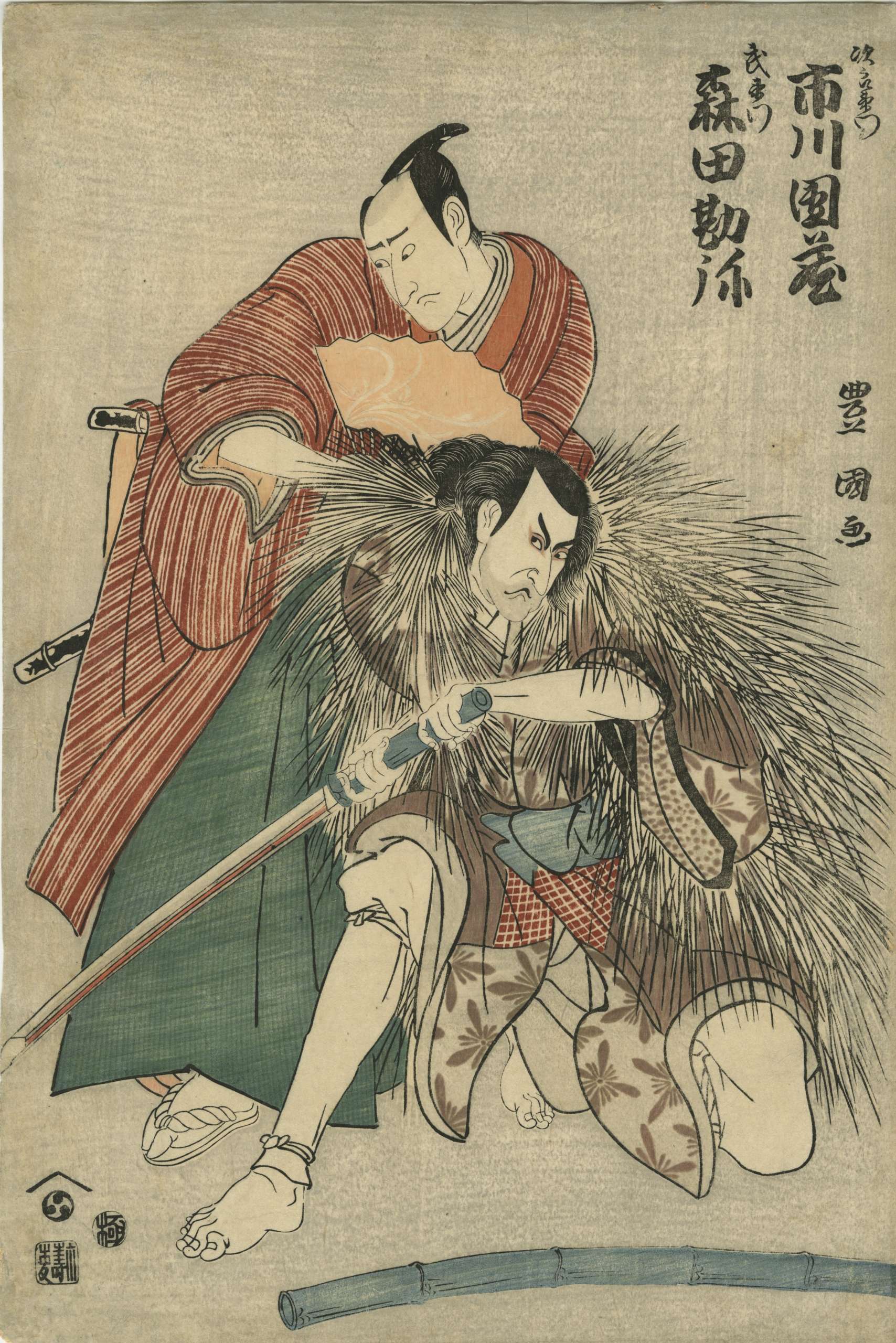 Utagawa Toyokuni (歌川豐國); 1769 – 24 February 1825. The kabuki actors Ichikawa Danzo IV as Jiroemon (in draw cape) and Morita Kanya VIII as Buemon. Play 'Oriai Tsuzure no Nishiki', performed at the Moritaza Theater in the 7th month of 1798. Publisher: Eijudo.
Utagawa Toyokuni (歌川豐國); 1769 – 24 February 1825. The kabuki actors Ichikawa Danzo IV as Jiroemon (in draw cape) and Morita Kanya VIII as Buemon. Play 'Oriai Tsuzure no Nishiki', performed at the Moritaza Theater in the 7th month of 1798. Publisher: Eijudo. -
 Iron tsuba of round form with design of diamond-shaped family crest (waribishi-mon) in openwork (sukashi). Bevelled, raised rim. Kozuka-hitsu-ana plugged with tin or lead. Ko-Katchushi school. Early Muromachi period: Early 15th century (Oei era). Size: Height: 89.3 mm. Width: 89.0 mm. Rim thickness: 4.3 mm. Center thickness: 2.9 mm. Provenance: Sasano Masayuki Collection, № 41: "In this tsuba, a family crest incorporating four lozenges sits upright on the right side of the nakago-ana. The straight lines of the lozenge add substance and power. Initially, the crest creates confusion regarding the age, yet the overall impression is one lacking in vigor and probably dates rather later than Nanbokucho period".
Iron tsuba of round form with design of diamond-shaped family crest (waribishi-mon) in openwork (sukashi). Bevelled, raised rim. Kozuka-hitsu-ana plugged with tin or lead. Ko-Katchushi school. Early Muromachi period: Early 15th century (Oei era). Size: Height: 89.3 mm. Width: 89.0 mm. Rim thickness: 4.3 mm. Center thickness: 2.9 mm. Provenance: Sasano Masayuki Collection, № 41: "In this tsuba, a family crest incorporating four lozenges sits upright on the right side of the nakago-ana. The straight lines of the lozenge add substance and power. Initially, the crest creates confusion regarding the age, yet the overall impression is one lacking in vigor and probably dates rather later than Nanbokucho period". -
 The thin, four-lobed iron plate of brownish color is carved on each side with two concentric grooves in the middle of the web, and with four thin scroll lines (handles, kan) that follow the shape of the rim. The hitsu-ana were added at a later date. Copper sekigane. Kamakura-bori school. Muromachi period, circa 1400-1550. Size: Height 80.4 mm, width 79.0 mm, thickness 3.2 mm at seppa-dai and 2.7 mm at the rim. Weight: 97.7 g. NBTHK Certificate №4004241: 'Hozon' attestation. As for the motif: the concentric circles is a widespread and generic design. It is described by John W. Dower [The Elements of Japanese Design, 1985, p. 132, #2201-30] as follows: Circle: Enclosure (wa). As a crest by itself, the cirlce carries obvious connotations of perfection, harmony, completeness, integrity, even peace. [...] Ordinary circles are labeled according to their thickness, with terminology ranging from hairline to "snake's eye". The motif that is described by both Compton Collection and R.E. Haynes as "scrolls", presented by John W. Dower as "Handle (kan): Although probably a purely ornamental and nonrepresentational design in origin, over the centuries this motif acquired the label kan, denoting its resemblance to the metal handles traditionally used on chests of drawers. [...] Very possibly the "handle" motif represents an early abstract version of the popular mokko, or melon pattern." Early Chinese Taoists claimed that special melon was associated with the Eastern Paradise of Mount Horai just as life-giving peaches were associated with the Western Paradise of the Kunlun Mountains. [...] A design motif called mokko (also translated as "melon" in accordance with the two ideographs with which it is written) may have nothing to do with the fruit. Mokko designs... are widely used as crests of both private families and Shinto shrines and are repeated as background designs that evoke a sense of classicism" [Symbols of Japan. Merrily Baird, 2001]. There is a look alike tsuba at Dr. Walter A. Compton Collection, 1992, Christie’s auction, Part II, pp. 14-15, №16:
The thin, four-lobed iron plate of brownish color is carved on each side with two concentric grooves in the middle of the web, and with four thin scroll lines (handles, kan) that follow the shape of the rim. The hitsu-ana were added at a later date. Copper sekigane. Kamakura-bori school. Muromachi period, circa 1400-1550. Size: Height 80.4 mm, width 79.0 mm, thickness 3.2 mm at seppa-dai and 2.7 mm at the rim. Weight: 97.7 g. NBTHK Certificate №4004241: 'Hozon' attestation. As for the motif: the concentric circles is a widespread and generic design. It is described by John W. Dower [The Elements of Japanese Design, 1985, p. 132, #2201-30] as follows: Circle: Enclosure (wa). As a crest by itself, the cirlce carries obvious connotations of perfection, harmony, completeness, integrity, even peace. [...] Ordinary circles are labeled according to their thickness, with terminology ranging from hairline to "snake's eye". The motif that is described by both Compton Collection and R.E. Haynes as "scrolls", presented by John W. Dower as "Handle (kan): Although probably a purely ornamental and nonrepresentational design in origin, over the centuries this motif acquired the label kan, denoting its resemblance to the metal handles traditionally used on chests of drawers. [...] Very possibly the "handle" motif represents an early abstract version of the popular mokko, or melon pattern." Early Chinese Taoists claimed that special melon was associated with the Eastern Paradise of Mount Horai just as life-giving peaches were associated with the Western Paradise of the Kunlun Mountains. [...] A design motif called mokko (also translated as "melon" in accordance with the two ideographs with which it is written) may have nothing to do with the fruit. Mokko designs... are widely used as crests of both private families and Shinto shrines and are repeated as background designs that evoke a sense of classicism" [Symbols of Japan. Merrily Baird, 2001]. There is a look alike tsuba at Dr. Walter A. Compton Collection, 1992, Christie’s auction, Part II, pp. 14-15, №16: The description goes: “A kamakurabori type tsuba, Muromachi period, circa 1400. The thin, six-lobed iron plate is carved on each side with a wide groove that follows the shape of the rim, and with six scroll lines and a single thin circular groove. […] The hitsu-ana was added at a later date, circa 1500-1550. Height 8.3 cm, width 8.6 cm, thickness 2.5 mm. The tsuba was initially intended to be mounted on a tachi of the battle type in use from Nambokucho to early Muromachi period (1333-1400)”. Sold at $935.
And another one in Robert E. Haynes Catalog #9 on page 24-25 under №23:
The description goes: “A kamakurabori type tsuba, Muromachi period, circa 1400. The thin, six-lobed iron plate is carved on each side with a wide groove that follows the shape of the rim, and with six scroll lines and a single thin circular groove. […] The hitsu-ana was added at a later date, circa 1500-1550. Height 8.3 cm, width 8.6 cm, thickness 2.5 mm. The tsuba was initially intended to be mounted on a tachi of the battle type in use from Nambokucho to early Muromachi period (1333-1400)”. Sold at $935.
And another one in Robert E. Haynes Catalog #9 on page 24-25 under №23:
 R.E. Haynes description: “Typical later Kamakura-bori style work. This type of plate and carving show the uniform work produced by several schools in the Muromachi period. Some had brass inlay and others were just carved as this one is. The hitsu are later. Ca. 1550. Ht. 8.8 cm, Th. 3.25 mm”. Sold for $175.
R.E. Haynes description: “Typical later Kamakura-bori style work. This type of plate and carving show the uniform work produced by several schools in the Muromachi period. Some had brass inlay and others were just carved as this one is. The hitsu are later. Ca. 1550. Ht. 8.8 cm, Th. 3.25 mm”. Sold for $175.
-
 A circular iron tsuba with a design of three monkey toys (kukurizaru) in small openwork (ko-sukashi); the plate further decorated with four rows of brass dot inlay (ten-zogan). The center of the plate and the openings are outlined with brass wire. Copper sekigane. A few dots missing. Muromachi period. Dimensions: 89.0 x 88.2 x 2.9 mm. Kukurizaru was an often used motif on old tsuba. The symbol has two explanations: (1) "upright" monkey, a sort of roly-poly toy, alludes to 'never-ever give up' property of the samurai; (2) monkeys are represented with their hands and feet tied to their back to symbolize self-control. Other examples of the same design:
A circular iron tsuba with a design of three monkey toys (kukurizaru) in small openwork (ko-sukashi); the plate further decorated with four rows of brass dot inlay (ten-zogan). The center of the plate and the openings are outlined with brass wire. Copper sekigane. A few dots missing. Muromachi period. Dimensions: 89.0 x 88.2 x 2.9 mm. Kukurizaru was an often used motif on old tsuba. The symbol has two explanations: (1) "upright" monkey, a sort of roly-poly toy, alludes to 'never-ever give up' property of the samurai; (2) monkeys are represented with their hands and feet tied to their back to symbolize self-control. Other examples of the same design:
The Henry D. Rosin Collection №9.

Lundgren Collection №7.
-

Iron tsuba of circular form with the knotted geese (kari) flying over the rough waves pierced (sukashi) and carved in low relief (nikubori). Hitsu-ana plugged with soft metal. Hitsu-ana plugged with soft metal (tin or lead).
Signed: Echizen koku jū Myochin Katsuharu saku.
Edo period.Size: Height: 80.7 mm; Width: 81.0 mm; Thickness: 4.5 mm; Weight: 110 g.
Two tsuba of this master can be found at Georg Oeder Collection (Japanische Stichblätter und Schwertzieraten. Sammlung Georg Oeder Düsseldorf. Beschreibendes Verzeichnis von P. Vautier. Herausgegeben von Otto Kümmel.Oesterheld & Co / Verlag / Berlin, Oesterheld, 1915; LIB-1465 in this collection) under №№ 172 and 173, page 21, though no illustrations. SOLD.


